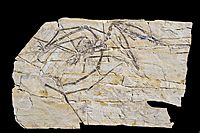Darwinopterus facts for kids
Quick facts for kids DarwinopterusTemporal range: Middle Jurassic, 160 million years ago
|
|
|---|---|
 |
|
| D. modularis fossil | |
| Scientific classification | |
| Kingdom: | |
| Phylum: | |
| Class: | |
| Order: | |
| Suborder: | |
| Type species | |
| Darwinopterus modularis Lü et al., 2010
|
|
| Species | |
|
D. modularis Lü et al., 2010 |
|
Darwinopterus (which means "Darwin's wing") was a type of pterosaur, an ancient flying reptile. It was discovered in China and named after the famous scientist Charles Darwin.
This amazing creature is special because it had features from two different groups of pterosaurs. It had traits from both the long-tailed pterosaurs (called rhamphorhynchoids) and the short-tailed pterosaurs (called pterodactyloids). This makes Darwinopterus a transitional fossil, showing how one group might have evolved into another.
Scientists have found about 30 to 40 fossils of Darwinopterus. All of these fossils came from rocks in China that are about 160 million years old. This time period is known as the Middle Jurassic. The first species, D. modularis, was described in 2010. Later, two more species, D. linglongtaensis and D. robustodens, were also found and described.
Fossils show that male and female Darwinopterus looked a bit different. This is called sexual dimorphism. Males had cool crests on their heads, and their hips were narrower than the females' hips.
What Made Darwinopterus Unique?
Darwinopterus and its close relatives had a mix of old and new features. This combination is common in transitional fossils, which are like "missing links" in evolution. Scientists call this "mosaic evolution."
For example, Darwinopterus kept the long tails seen in older rhamphorhynchoids. But it also had new features found in more advanced pterodactyloids. These included long bones in its neck and a single large opening in its skull, right in front of its eyes.
How Darwinopterus Laid Eggs
One incredible fossil of Darwinopterus was found with an egg! This discovery gave scientists clues about how these flying reptiles reproduced. It also helped us understand how pterosaurs in general laid their eggs.
Just like the eggs of modern reptiles, Darwinopterus eggs had a soft, leathery shell. This is different from bird eggs today, which have hard shells made of calcium carbonate. Soft-shelled eggs can absorb water from their surroundings as the baby grows inside.
Because these eggs were soft and could absorb water, they were likely buried in the soil. This would protect them from drying out or being damaged. Scientists think that Darwinopterus probably laid many small eggs at one time. Once the babies hatched, they could fly right away and didn't need much help from their parents.
These findings suggest that pterosaurs reproduced more like modern reptiles than like modern birds.
Images for kids
See also
 In Spanish: Darwinopterus para niños
In Spanish: Darwinopterus para niños


